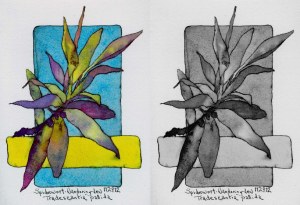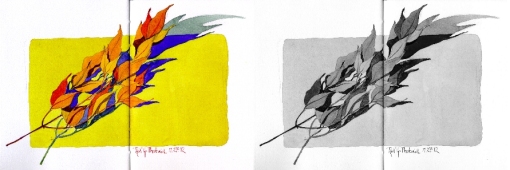To read the history of this Craftsman Electric Hair Clipper, read today’s post on Third Time Around.

Hair Clipper – Full Color and Grayscale
One method of painting by color value is to use full intensity colors, choosing the hue based on its intrinsic value at full intensity.

Intrinsic Color Value at Full Intensity
This is not a perfect color value scale. The blue and the green were too diluted and dried lighter than I would like. However, you get the idea …. I hope.
As you can see, yellow is always your lightest light. Violet is always your darkest dark. When it comes to everything between white and black, you can choose from either side of the diamond. If you haven’t played around with this before, I suggest you use the left side (oranges and reds) for the surfaces that are illuminated by your light source. Use the right side (greens and blues) for the surfaces in shadow.
Or, if you are really adventurous, mix and match all you want and you will still come out with a strong painting as long as you choose your hues to correspond correctly to the values seen on the objects you are using as models.

Grayscale
I began with a line drawing using a dip pen and “Nessie” ink. Using a limited palette of only three hues (Aureolin, Permanent Alizarin and French Ultramarine Blue) I mixed the other hues I needed to correspond with the values I wanted. I mixed a yellow-orange, orange, yellow-green, green, and a slightly darker green moving toward blue-green.
First I painted the darkest dark, the shadows. I let that dry completely so that I could see exactly how dark the violet shadows ended up. The second wash was the background, the yellow-orange. These two washes define my value range, my lightest light (other than the white paper) and my darkest dark. I then worked dark to light starting on the shadow side of the clipper and making my way around the surfaces from shadow to illuminated planes.
When I got to the clipper attachment I totally forgot what my goal was and simply played with the ink bleeding into a diluted blue-violet mix. It is difficult to shut off my intuitive actions.
Family Treasures No.47 – Craftsman Electric Hair Clipper
I present this and other methods of painting by color value in the Color Value Workshops.




















